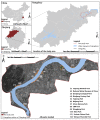Landscape Aesthetic Value of Waterfront Green Space Based on Space-Psychology-Behavior Dimension: A Case Study along Qiantang River (Hangzhou Section)
- PMID: 36833810
- PMCID: PMC9964288
- DOI: 10.3390/ijerph20043115
Landscape Aesthetic Value of Waterfront Green Space Based on Space-Psychology-Behavior Dimension: A Case Study along Qiantang River (Hangzhou Section)
Abstract
As an important part of urban green infrastructure, the landscape effect of the urban waterfront green space varies, and sometimes, the green space with an excellent landscape aesthetic value fails to serve the needs of most citizens. This seriously affects the construction of a green ecological civilization and the implementation of the concept of "common prosperity" in China. Based on multi-source data, this study took the Qiantang River Basin as an example, selected 12 representative waterfront green spaces along the river as the research objects, and used qualitative and quantitative analysis methods to determine the landscape aesthetic value of the research area from the different dimensions of space, psychology, and physiology. We examined the relationship between each dimension so as to objectively and comprehensively reflect the landscape value characteristics of the waterfront green space in the study area and provide a reasonable theoretical framework and practical development path for future urban waterfront green space landscape design. We obtained the following results: (1) The results of the spatial dimension research indicated that the spatial value index of the waterfront green space in the study area was three-dimensional space > vertical space > horizontal space, and the overall spatial value was low; Qianjiang Ecological Park obtained the highest value (0.5473), and Urban Balcony Park obtained the lowest value (0.4619). (2) The results of the psychological dimension indicated that people's perceptions of the waterfront green space in the study area were relatively weak, mainly focusing on visual perception, but the waterfront green space with a relative emotional value greater than one accounted for 75%, and the overall recognition of the landscape was high. (3) The results of the behavioral dimension showed that the overall heat of the waterfront green space in the study area was insufficient (1.3719-7.1583), which was mainly concentrated in low-heat levels, and the population density was unevenly distributed (0.0014-0.0663), which was mainly concentrated in the medium-density level. The main purpose of users was to visit, and they stayed an average of 1.5 h. (4) The results of the coupling coordination analysis of the spatial-psychological-behavioral dimensions showed that the landscape value of the waterfront green space in the study area presented a form of 'high coupling degree and low coordination degree'.
Keywords: behavior observation; heat map; horizontal–vertical–three-dimensional space evaluation model; landscape aesthetic value; spatial–psychological–behavioral dimension; urban waterfront spaces.
Conflict of interest statement
The authors declare that the research was conducted in the absence of any commercial or financial relationships that could be construed as a potential conflict of interest.
Figures







Similar articles
-
Citizens' preferences and attitudes towards urban waterfront spaces: a case study of Qiantang riverside development.Environ Sci Pollut Res Int. 2020 Dec;27(36):45787-45801. doi: 10.1007/s11356-020-10419-6. Epub 2020 Aug 15. Environ Sci Pollut Res Int. 2020. PMID: 32803586 Free PMC article.
-
Interaction of Urban Rivers and Green Space Morphology to Mitigate the Urban Heat Island Effect: Case-Based Comparative Analysis.Int J Environ Res Public Health. 2021 Oct 29;18(21):11404. doi: 10.3390/ijerph182111404. Int J Environ Res Public Health. 2021. PMID: 34769917 Free PMC article.
-
Revitalization of the Waterfront Park Based on Industrial Heritage Using Post-Occupancy Evaluation-A Case Study of Shanghai (China).Int J Environ Res Public Health. 2022 Jul 26;19(15):9107. doi: 10.3390/ijerph19159107. Int J Environ Res Public Health. 2022. PMID: 35897471 Free PMC article.
-
[Impacts of urban cooling effect based on landscape scale: a review].Ying Yong Sheng Tai Xue Bao. 2015 Feb;26(2):636-42. Ying Yong Sheng Tai Xue Bao. 2015. PMID: 26094483 Review. Chinese.
-
Effects of urban green space landscape pattern on flood retention efficiency from "urban-block" scale perspective.Ying Yong Sheng Tai Xue Bao. 2024 Feb;35(2):533-542. doi: 10.13287/j.1001-9332.202402.022. Ying Yong Sheng Tai Xue Bao. 2024. PMID: 38523112 Review. English.
Cited by
-
Physiological and psychological effects of visits to different linear Spatial landscape on the students: a field experiment in the campus environment.J Health Popul Nutr. 2025 May 6;44(1):145. doi: 10.1186/s41043-025-00903-5. J Health Popul Nutr. 2025. PMID: 40329427 Free PMC article.
References
-
- Taufen A., Yocom K. Transitions in Urban Waterfronts: Imagining, Contesting, and Sustaining the Aquatic/Terrestrial Interface. Sustainability. 2021;13:366. doi: 10.3390/su13010366. - DOI
-
- Dai F., Wang Y., Chen M., Huang Y., Guo L. Study on the Planning and Protection of Waterfront Green Space Under the Vision of “Park City”: A Case Study of Hundreds-kilometers Riverbank Parks Group of the Yangtze River in Wuhan. Shanghai Urban Plan. Rev. 2019;1:19–26.
-
- Ahmed S., Meenar M., Alam A. Designing a Blue-Green Infrastructure (BGI) Network: Toward Water-Sensitive Urban Growth Planning in Dhaka, Bangladesh. Land. 2019;8:138. doi: 10.3390/land8090138. - DOI
Publication types
MeSH terms
LinkOut - more resources
Full Text Sources
Research Materials

